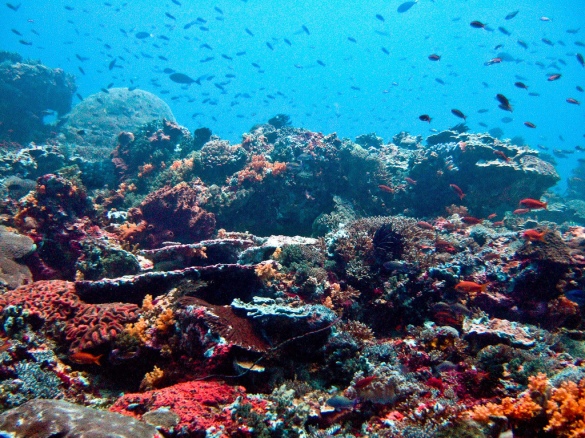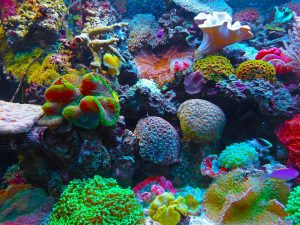When you first see this picture below of a coral reef landscape, you are captivated. Captivated by the beautiful, bright, elegant colors popping through the clear blue water. But why? Why do these coral reefs have such bright, bold colors? The colors found in colorful corals are mostly due to three things – photosynthetic pigments, fluorescent proteins, and non-fluorescent chromoproteins.

Coral Polyps
In order to understand why corals get their color, it is important to first learn the structure of the coral polyps. The majority of polyps have clear, transparent bodies over their hard, white skeletons. Millions of zooxanthellae live inside the tissues of these polyps. These zooxanthellae produce pigment, and because they reside in the clear tissue of the polyp, the pigments are visible, and the corals get their beautiful colors.

Light Intensity Dependency
Zooxanthellae are photosynthetic algae, and in order to ensure there is a continuous amount of nutrients being delivered to the coral, the coral regulates the number of zooxanthellae cells, as well as the amount of chlorophyll in them. Because zooxanthellae is a photosynthetic algae, zooxanthellae are sensitive to light intensity, which can ultimately alter the color and overall health of the coral. Too much light intensity can release some zooxanthellae, or the amount of chlorophyll will be decreased. In the presence of harsh light intensity, it can potentially be detrimental to the coral reef by excess oxygen production, causing it to accumulate and have toxic effects on the coral. If the light intensity is insufficient, the zooxanthellae will not be able to provide enough nutrients for the host coral, and thus the number of zooxanthellae and amount of chlorophyll will increase. When the zooxanthellae cells use light to produce large organic compounds, oxygen is also released. The brighter the color of the coral, the more photosynthesis and oxygen production. Corals can decrease or increase the chlorophyll production from the zooxanthellae cells, depending on environmental requirements. They can also expel zooxanthellae when under stress.
So, what does this mean? Essentially, the number of zooxanthellae and the amount of chlorophyll affect coral coloration. Because zooxanthellae cells range in color from a golden-yellow to brown, and when there is a large number of zooxanthellae cells present the coral color appears brown, it suggests that the light intensity affects the number of zooxanthellae and the amount of chlorophyll.
Why are some more colorful than others?

Corals are home to different types, or clades of zooxanthellae, that vary in light intensity sensitivity and temperature. While zooxanthellae color can range from a golden-yellow to a brown pigment, zooxanthellae can also fluoresce deep red color under certain circumstances. For example, Phycoerythrin is a photosynthetic pigment that fluoresces a bright orange color that’s found in zooxanthellae. In addition, there are about 85 more fluorescent pigment colors produced by colorful corals, typically cyan, green, yellow, and red, and they can even glow in the right lighting! These proteins absorb light of one color (wavelength) and emit (fluoresce) a different (lower energy wavelength) color. There are also other pigments produced by the coral called chromoproteins, they are non-fluorescent, or reflective, and there are about 24 chromoproteins found in corals. Of the 24 chromoproteins, the pigments can appear as purple, red, blue, to name just a few.

Coral Reef by Jan-Mallander via Pixabay [CC 2.0]
What Are the Roles of the Corals Colors?
It is thought that these fluorescent compounds may help corals survive, however, the role is not yet well understood. A few possibilities are that they may serve as a “sunscreen” protecting corals by filtering out harmful ultraviolet rays. Corals can manipulate the zooxanthellae cells in response to light. Only recently have scientists begun to comprehend the relationship between color-producing light and how it appears at different depths. Wavelengths of light become diluted the deeper down they have to travel. UV light rays are naturally filtered out by water in deeper oceanic regions. That’s why shallow-water reefs are bright with color and deeper coral tend to appear more gray-like. It has also been shown that injured corals often form colorful patches. This is due to the fact that the coral is making fluorescent molecules that act as antioxidants, capturing toxic oxygen radicals that threaten to damage cells.
The information in this chapter is thanks to content contributions from Jaime Marsh and Haley Zanga
